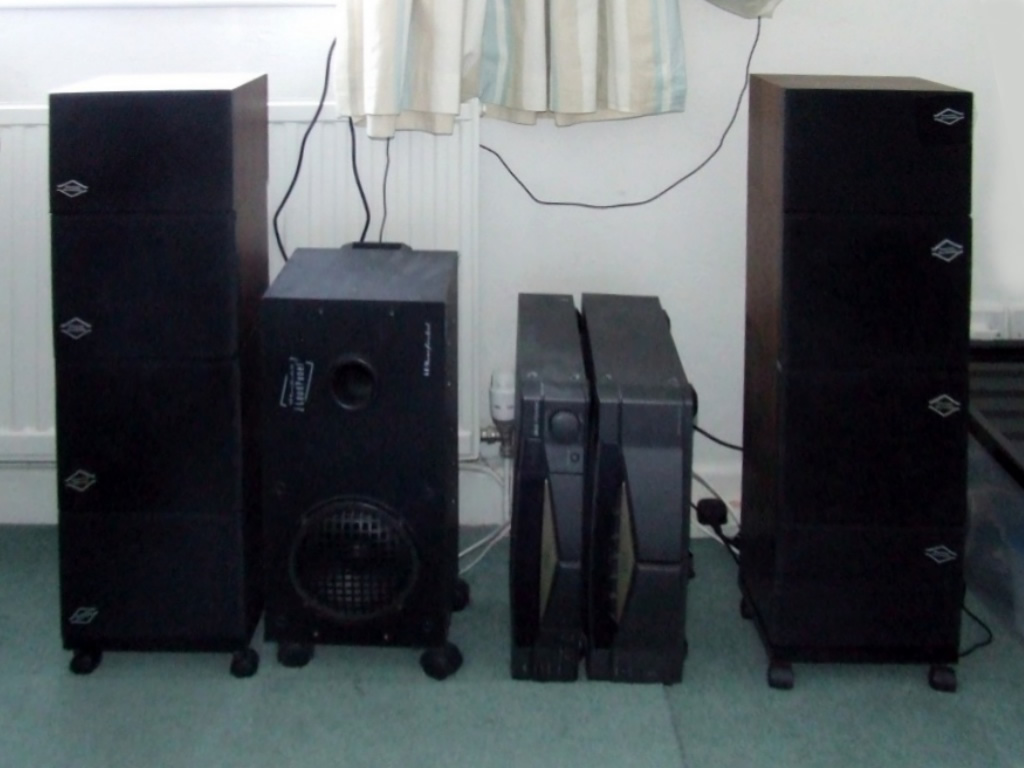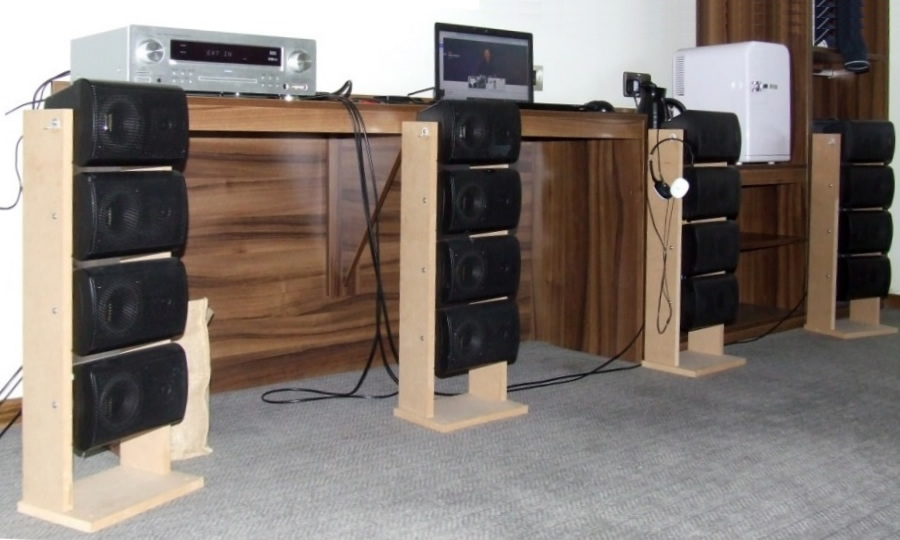Hurst Audio - powerful speaker arrays for home use

Line array speakers can be very impressive, due to their high power handling capacity, reduced intermodulation distortion and solid bass output. This gives them a characteristic "big" sound. However, this level of performance can be expensive, and hand-building substantial speakers from scratch is not for the DIY novice. But what if there were pre-assembled modules widely available that could easily be assembled into powerful arrays, at knocked-down prices? Well, there are. They are the myriad second-hand book-shelf speakers, which, when new, were sold by the shed load at highly competitive prices. These can be picked up today from internet auction sites for a fraction of their cost when new.
You need four pairs of book-shelf speakers to build a pair of line arrays. It is generally preferable to settle on one model built by one manufacturer, because the results are more predictable. Different speaker designs have differing advantages. E.g. Speakers that have rectangular cases (like the vintage Wharfedale Diamond I's above) have the advantage that you just have to stack them on tbeir sides four units high, wire them up, and you have your line arrays! You can worry about a more permanent construction later. Whilst the Ariston Acoustics MSX-07's (in the lower illustration) need a wooden frame to mount the speakers on. The wood can be obtained cut-to-size with holes pre-drilled. They can even supply the requisite screws, so that only the simplest of home-assembly is required.
Wireing The Speaker Arrays
The speakers need to be connected to the amplifier in a manner that does not risk damaging the amplifier. For example, if one core of the cable connects all the +ve terminals of the speakers to each other and to the +ve terminal on the amplifier, and the other core conects the -ve terminals of the speakers to each other and to the -ve terminal on the amplifier, this would connect all the speakers in parallel. As a result of this, the 6 to 8 ohm nominal load seen by the amplifier would drop to a dangerous 1.5 to 2 ohm. Whereas, if the speakers were connected in series, the load seen by the amplifier would be 24 to 32 ohms. This reduces the efficiency of the speakers. So the amplifier has to work harder to acieve the same output level.
The preferred way to connect the speakers to the amplifier is as a series-parallel array:

-
The -ve terminal of #1 is connected to the +ve terminal of #2.
-
The -ve terminal of #3 is connected to the +ve terminal of #4.
-
The +ve terminal of #1 is connected to the +ve terminal of #3.
- The -ve terminal of #2 is connected to the -ve terminal of #4.
-
The +ve terminal of #1 or #3 is connected to the +ve terminal of the left channel of the amplifier.
-
The -ve terminal of #2 or #4 is connected to the -ve terminal of the left channel of the amplifier.
This is then repeated for the other stack(s)...
Achieving a Wider Stereo Field
Another aspect of a "big" sound is the width of the stereo field. Stereo recordings can capture sounds from a horizontal arc up to 180 degrees. However, the stereo field that can be produced by two speakers is limited to the distance between them. So, if the speakers are placed 1.2m (4ft) apart, the stereo field produced is 1.2m (4ft) wide (or less).
So the width of the stereo field reproduced may often be much narrower than tyhe original sources. if you are looking to widen the stereo field of stereo recordings, you have a problem. If you simply increase the spacing between adjacent speakers, the central images between the speakers become increasingly bloated. So instead of widening the speaker-to-speaker spacing we add a second pair of stacks beside them. When spaced 1.2m apart the four stacks can double the width of the stereo field to 2.4m which is a dramatic improvement, and draws you into the imagery.

The stacks should generally be placed along the longer wall of the room. The outer pair may be turned inwards, whilst the inner pair face forwards. The listener should be at least as far from the speaker line as the speaker-to-speaker distance, whilst some listeners may prefer being up to three times that distance.
Note: You need to have four power amplifier channels, two for the speakers to the left, and two for those on the right. It may be beneficial to be able to reduce the level fed to the outer pair of channels by upto 6dB with respect to the inner. No crossfeed between the left and right channels is required or desired. I.e. The only difference between the signals
fed to the inner and outer channels is the optional ability to vary the volume of the outer channels in the range +0 to -6dB.
Requests for further information on building the stacks, and any other enquiries, should be addressed to tlhurst@hotmail.co.uk
Last update: 10th August 2024.


